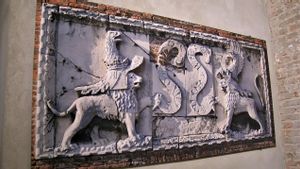JAKARTA - The history of kretek can never be separated from the figure of Nitisemito. He was the boss of the most successful kretek cigarettes in the archipelago during the Dutch era.
His success in building his business empire impressed the First President of the Republic of Indonesia, Soekarno. Even a totok is willing to work for this native. No wonder he got the nickname the King of Kretek from Kudus.
Born in 1863 in Kudus, Nitisemito has the nickname Roesdi Bin Soelaiman. His father is a village head.
Nitisemito also enjoyed his blue blood childhood, carrying out the status of a village priyayi. However, Nitisemito did not receive a formal education like the children of other village heads.
The soul as a reformer has been planted since he was 17 years old. At that time he refused to continue his father as a state servant. Nitisemito wanted to be a trader.
One day Nitisemito tried his luck by migrating to Malang. With a little capital from his father, he briefly tried to work as a sewing laborer and opened his own sewing house. However, his business failed because the competition was so intense. He returned home.
In Kudus, Nitisemito started a new business from scratch. He has ever explored almost everything, from buffalo to coconut oil to the skipper. However, to no avail.
Until one day he thought of making kretek cigarettes and selling them. Here is the turning point before becoming king.
Quoted from Bedjo Riyanto in the book Siasat Mengemas Favors (2019), Nitisemito started to earn a fortune by selling his own small cigarettes in 1910. Slowly but surely, after 12 years of selling cigarettes, he began to reap huge profits.
Building industryNitisemito also founded a klobit cigarette business under the brand Tjap Kodong Mangan Ulo (Cap Kodok Eating Snake). However, because he became a laughing stock, Nitisemito replaced his brand with a three-circle image as a label without writing or product name. This uniqueness is what makes Nitisemito's cigarette products successful and in demand in the market.
People call it by various names, such as 'Bal Teloe', 'Bal Tiga', or 'Tiga Bola'. This success led Nitisemito to become the pioneer of the first kretek cigarette industry for Bumiputra. It was also what made him nicknamed the King of Kretek (kretek kooning) by the Dutch East Indies.
With the success of Bal Tiga, Nitisemito began to apply modern management by concentrating production in one factory area. Initially the rolling workers brought their work to their respective homes, so they worked directly in the factory by rolling cigarettes during certain working hours, every day. As a form of seriousness, Nitisemito then hired a white accountant HJ Voren and an accountant from the Dutch colonial government named Poolman.
This rapid development has made Bal Tiga cigarettes criss-cross the big cities throughout the archipelago. The marketing coverage area includes Java, Sumatra, Sulawesi, Kalimantan, and is even able to export to the Netherlands. As stated by JA Noertjahyo in the book 1000 Tahun Nusantara (2000), Cap Bal Tiga was officially put into use in 1924-1925.
"Between 1930-1934, the production was only around 2-3 million cigarettes / day. In 1938, production jumped up to 10 million sticks / day with around 10 thousand workers, "said JA Noerjahyo.
InnovativeNitisemito always finds a way to make his wares hunted by people. He is an innovator. In fact, you could say that he became one of the pioneers in implementing creative marketing strategies in the archipelago.
Nitisemito is also brave enough to try new things. to the point that, he formed a marketing department of 20 people just to introduce Bal Tiga throughout the archipelago. Therefore, Nitisemito surpassed the businessmen of his time, including those of Europe.
Some of them Nitisemito uses marketing techniques to sell Bal Tiga with the lure of gifts, such as wall clocks, glasses, watches, beautiful plates, to bicycles. The prize was what made Nitisemito's sales increase and Bal Tiga reached the peak of his glory. The record of Bal Tiga's success was re-revealed by Ratih Kumala in his historical novel entitled Gadis Kretek (2012).
Ratih revealed that a set of teapots and cups depicting three rings as gifts from Bal Tiga kretek, often filled the homes of the native people of his time. Kretek made by Nitisemito was so famous and big because of the unusual way of promotion at that time.
"When it was in its prime, Kretek Bal Tiga gave many gifts with the kretek logo on the prizes. Starting from a small plate as a snack holder, a lighter, a teapot set, a tray, until the biggest one is a bicycle. The prizes can be obtained by exchanging a number of Kretek Bal Tiga packages, ”said Ratih.
Not only that, Nitisemito also often advertises his products by sponsoring traditional performances and modern theater events. It seems that there are countless events such as wayang kulit, ketoprak, wayang orang, and plays / tonil which have been sponsored by Nitisemito.
It's still not much. Nitisemito has excited residents in the cities of Bandung, Bogor, Batavia, Semarang and Surabaya with his great promotions. At that time, Nitisemito rented a company Fokker F.VII plane. An airplane with a white muzzle with a PK-AFC back number was chartered by Nitisemito for 200 guilders per flight.
The story was later made into a historical novel by Iksaka Banu with the title Sang Raja (2017). Iksaka Banu wrote about the atmosphere when the Fokker plane flew over a field that was busy with residents. Instantly, from above Fokker scattered thousands of white papers like rain. The residents immediately took the leaflets and shouted with joy.
“When we (Bal Tiga Team) gathered again at the office, all field officers reported the same findings. Both in Surabaya, Semarang, Buitenzorg (Bogor), even Batavia, for days the visitors kept talking about the planes that distributed the flyers. And the income reports for the following months are quite encouraging. The price of cigarettes was successfully held at the limit of 6 cents for a long time, ”wrote Iksaka Banu.
Praised by the presidentThe success of the kretek king was praised by Soekarno when he gave a speech at the Session of the Indonesian Independence Preparatory Research Agency (BPUPKI) on June 1, 1945. It is said that Nitisemito was the main supporter of Sarekat Islam (SI) and often helped the struggle for independence.
"We established the Indonesian state, which we all have to support. All for all! Not Christians for Indonesia, not Islamic groups for Indonesia, not Hadikoesoemo for Indonesia, not Van Eck for Indonesia, not rich Nitisemito for Indonesia, but Indonesia for Indonesia, all for all, "said Bung Karno.
Several years after Indonesia's independence, namely on March 7, 1953 Nitisemito died. He was buried in Krapyak, Kudus.
His departure at the same time closed the story of the famous Bal Tiga. Various internal conflicts, developing political dynamics, and whether or not regeneration were the main causes of Bal Tiga's bankruptcy.
Even though his kingdom had collapsed, Nitisemito's name was still remembered. His title as the King of Kretek from Kudus is eternal until this moment.
The English, Chinese, Japanese, Arabic, and French versions are automatically generated by the AI. So there may still be inaccuracies in translating, please always see Indonesian as our main language. (system supported by DigitalSiber.id)











